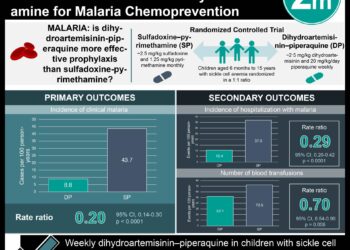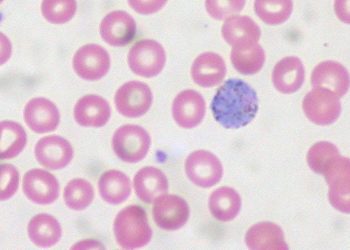Gene mutation associated with antimalarial resistance across Southeast Asia
1. High rates of artemisinin resistance in Plasmodium falciparum malaria were detected in western Cambodia and eastern Thailand.
2. Infection with a kelch13 gene mutation was strongly associated with artemisinin resistance.
Evidence Rating Level: 1 (Excellent)
Study Rundown: This randomized, controlled trial aimed to map artemisinin resistance in P. falciparum across sites in Southeast Asia and Africa and to demonstrate if prolonged treatment with artemisinin-based combination therapies can improve malaria cure rates. Artemisinin derivatives are a cornerstone of antimalarial treatment protocols in malaria endemic countries. They have been threatened recently by the emergence of artemisinin resistance in P. falciparum, which is characterized by slow parasite clearance after treatment and has been associated with point mutations in the P. falciparum kelch protein.
In this study, 1,241 patients with uncomplicated P. falciparum malaria were recruited from 15 sites in 10 countries and were randomized to receive a standard artesunate monotherapy at one of two doses, plus a 3-day course of artemisinin-based combination therapy. The highest rates of artemisinin-resistant malaria were found in western Cambodia and eastern Thailand, while rates were low in India and 3 sites in Africa. An infection with a mutation in kelch13 was associated with a substantially prolonged parasite clearance half-life. The mean parasite clearance half-life was similar between groups that received 3-day artesunate monotherapy at either dosage level. The 6-day prolonged course of combination therapy showed improvement over the standard 3-day regimen which has had increasing failure rates in areas where resistance is developing.
Strengths of the study include the randomized design and the ability to map out resistance patterns across a wide geographic area in Southeast Asia and Africa; these results will be essential for planning future antimalarial interventions. Drawbacks include the fact that while half-lives are an established surrogate measure for artemisinin resistance in P. falciparum, these are still influenced by antimalarial-drug dosing, pharmacokinetics, and host immunity. Furthermore, there were only a few sampling sites in India and Africa, so results cannot be generalized to these large geographic areas.
Click to read the study, published today in NEJM
Click to read the accompanying editorial in NEJM
Relevant Reading: Evidence of artemisinin-resistant malaria in western Cambodia
Study Author, Dr. Elizabeth A. Ashley, MB, BS, PhD, talks to 2 Minute Medicine: Lead Scientist, TRAC study, Clinical Researcher, Mahidol Oxford Tropical Medicine Research Unit, University of Oxford.
“Frontline [artemisinin-based combination therapies] (ACTs) are still very effective at curing the majority of patients. But we need to be vigilant as cure rates have fallen in areas where artemisinin resistance is established. Decisive action is needed to prevent the spread of resistance from Myanmar into neighbouring Bangladesh and India.”
In-Depth [randomized controlled trial]: This open-label, randomized trial was conducted across multiple sites in Southeast Asia and Africa and aimed to map artemisinin-resistance in P. falciparum across these regions. Patients were between 6 months and 65 years of age and had acute, uncomplicated falciparum malaria. They were randomly assigned to receive oral artesunate at either 2 mg/kg of body weight per day or 4 mg/kg per day, for 3 days, followed by a 3-day course of artemisinin-based combination therapy. The primary outcome was the parasite clearance half-life, a standard assay to detect artemisinin resistance. PCR amplification was used to genotype the full sequence of kelch13, a gene that has been associated with delayed parasite clearance.
A total of 1,241 patients with falciparum malaria were enrolled. Median parasite clearance half-life values ranged from 2 hours at one site in Laos to 7 hours at one site in Thailand; the highest rates of prolonged parasite clearance half-life (defined as >5 hours) occurred in western Cambodia and eastern Thailand. Parasite clearance half-life was 5 hours or less at one site in India and 3 sites in Africa. Single point mutations of kelch13 were associated with a mean increase in the parasite half-life of 116% (95% CI, 103 to 131; P<0.001); after adjusting for age, baseline parasite count, and dose of artesunate, an infection with a kelch13 mutation was significantly more likely to have a prolonged parasite clearance half life (odds ratio, 94.7; 95% CI, 54.6 to 164.0; P<0.001). The mean parasite clearance half-life values were similar between the low- and high-dose artesunate groups (P=0.13).
More from this author: Broad decline in incidence rate of diabetes-related complications in US, Darapladib not effective in optimized, stable coronary heart disease patients, Letermovir safe, effective in CMV prophylaxis following stem-cell transplantation, Combination CPAP, weight loss for obstructive sleep apnea offer no added benefit, Tofacitinib superior to methotrexate monotherapy for rheumatoid arthritis
Image: PD
©2012-2014 2minutemedicine.com. All rights reserved. No works may be reproduced without expressed written consent from 2minutemedicine.com. Disclaimer: We present factual information directly from peer reviewed medical journals. No post should be construed as medical advice and is not intended as such by the authors, editors, staff or by 2minutemedicine.com. PLEASE SEE A HEALTHCARE PROVIDER IN YOUR AREA IF YOU SEEK MEDICAL ADVICE OF ANY SORT.






